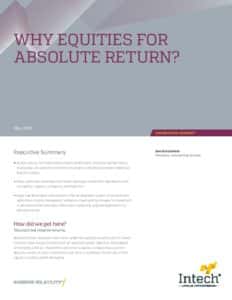Stockholm (HedgeNordic) – With interest rates still near their all-time lows and broad equity markets near all-time highs, the near-term outlook for market-beta returns has deteriorated. As a result, many institutional investors are increasingly shifting their focus to absolute return strategies to meet their investment objectives. In a whitepaper titled “Why Equities for Absolute Return?” freshly released by asset management firm Intech, one can learn of the challenges associated with implementing absolute return strategies today and learn of the traditional problems with using equities to deliver absolute returns.
Listed equities normally return better than any other asset class over time, perhaps except for cryptocurrencies if one thinks of them as an asset class (I hope, however, time will prove cryptocurrencies are not such a good long-term investment as some may believe). Although institutional investors have always invested with an absolute return objective, absolute return strategies have recently become the center of attention due to declining market-beta return expectations. The ever-evolving financial industry unceasingly develops new ways of building portfolios with an absolute return objective. However, as the whitepaper released by Intech points out, many of these financial products employ combinations of instruments that are complex, illiquid, expensive, and lacking transparency. And these issues often lead to capacity constraints that hinder institutional investors from making meaningful investments.
To learn more about the main five problems associated with the increasingly complex structures and instruments offered to institutional investors as a means of meeting their absolute return targets, read the whitepaper below:
Picture: (c) Tischenko-Irina—shutterstock.com

